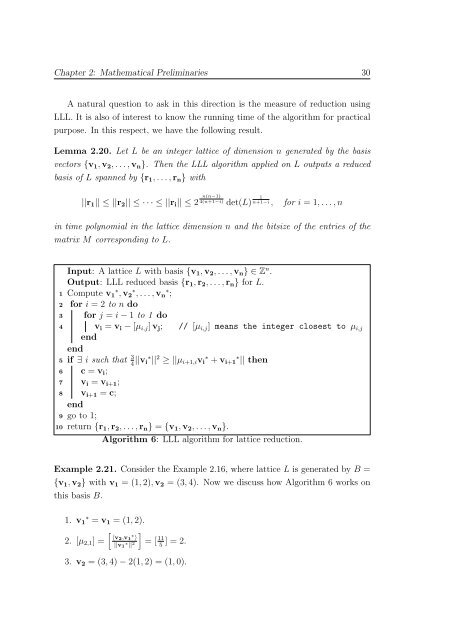Cryptanalysis of RSA Factorization - Library(ISI Kolkata) - Indian ...
Cryptanalysis of RSA Factorization - Library(ISI Kolkata) - Indian ...
Cryptanalysis of RSA Factorization - Library(ISI Kolkata) - Indian ...
You also want an ePaper? Increase the reach of your titles
YUMPU automatically turns print PDFs into web optimized ePapers that Google loves.
Chapter 2: Mathematical Preliminaries 30<br />
A natural question to ask in this direction is the measure <strong>of</strong> reduction using<br />
LLL. It is also <strong>of</strong> interest to know the running time <strong>of</strong> the algorithm for practical<br />
purpose. In this respect, we have the following result.<br />
Lemma 2.20. Let L be an integer lattice <strong>of</strong> dimension n generated by the basis<br />
vectors {v 1 ,v 2 ,...,v n }. Then the LLL algorithm applied on L outputs a reduced<br />
basis <strong>of</strong> L spanned by {r 1 ,...,r n } with<br />
||r 1 || ≤ ||r 2 || ≤ ··· ≤ ||r i || ≤ 2 n(n−1)<br />
4(n+1−i) det(L)<br />
1<br />
n+1−i , for i = 1,...,n<br />
in time polynomial in the lattice dimension n and the bitsize <strong>of</strong> the entries <strong>of</strong> the<br />
matrix M corresponding to L.<br />
1<br />
2<br />
3<br />
4<br />
5<br />
6<br />
7<br />
8<br />
9<br />
10<br />
Input: A lattice L with basis {v 1 ,v 2 ,...,v n } ∈ Z n .<br />
Output: LLL reduced basis {r 1 ,r 2 ,...,r n } for L.<br />
Compute v ∗ 1 ,v ∗ 2 ,...,v ∗ n ;<br />
for i = 2 to n do<br />
for j = i−1 to 1 do<br />
v i = v i −[µ i,j ]v j ;<br />
// [µ i,j ] means the integer closest to µ i,j<br />
end<br />
end<br />
if ∃ i such that 3||v 4 i ∗ || 2 ≥ ||µ i+1,i v ∗ i +v ∗ i+1 || then<br />
c = v i ;<br />
v i = v i+1 ;<br />
v i+1 = c;<br />
end<br />
go to 1;<br />
return {r 1 ,r 2 ,...,r n } = {v 1 ,v 2 ,...,v n }.<br />
Algorithm 6: LLL algorithm for lattice reduction.<br />
Example 2.21. Consider the Example 2.16, where lattice L is generated by B =<br />
{v 1 ,v 2 } with v 1 = (1,2),v 2 = (3,4). Now we discuss how Algorithm 6 works on<br />
this basis B.<br />
1. v ∗ 1 = v 1 = (1,2).<br />
[ ]<br />
2. [µ 2,1 ] = 〈v2 ,v ∗ 1 〉<br />
||v ∗ 1<br />
= [ 11] = 2. || 2 5<br />
3. v 2 = (3,4)−2(1,2) = (1,0).
















